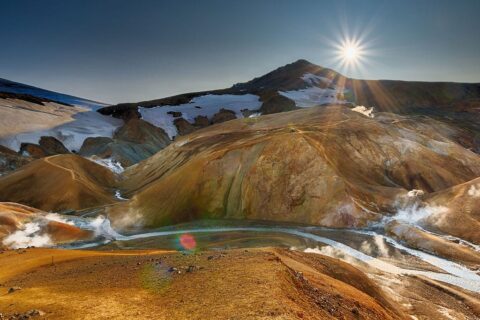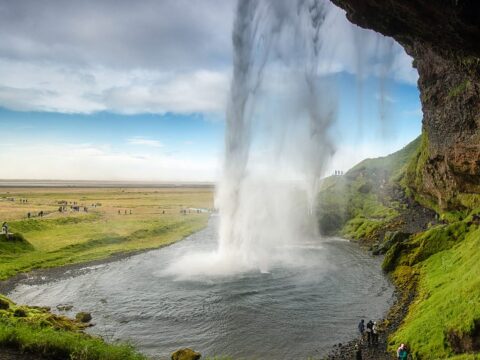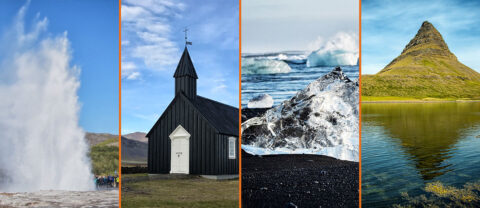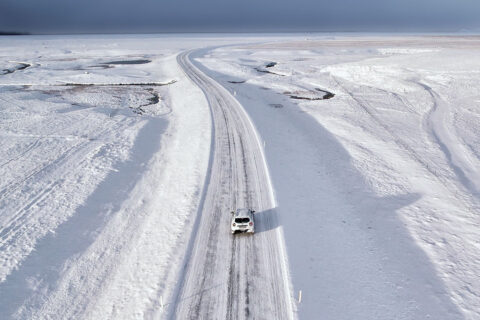Different seasons in Iceland offer different attractions to see, but also different challenges, different solutions to those challenges and different prices for those solutions…. In this article, we will describe when is the best time to go to Iceland and why, as well as how to organize a trip in each season.
What is the weather like in Iceland
We write in detail about the weather in Iceland in a separate article: Weather in Iceland – temperature, wind, precipitation Here, let’s just reiterate the most important findings from that text:
- Iceland has a maritime climate, so average air temperatures are never very high or very low. However, individual days can sometimes be extreme – especially weather breakdowns during storms can deviate very far from the averages.
- Typical air temperature in winter is around 0 °C / 32 °F, in spring and autumn 5-10 °C / 40-50 °F, and in summer about 15 °C / 60 °F. Be careful though: on individual days it can be slightly warmer, but also much colder. Snow and icy, undriveable roads are not overly surprising all the way from September to May! Night frosts – especially in the mountains – occur at any time of the year.
- An almost invariable – and perhaps most important – feature of Icelandic weather is strong or very strong wind. Especially in the interiors and Western Fjords, the wind is often really super strong. Between years 2000 and 2022, in every December, January, February and March, the Thverfjall station in the West Fjords recorded winds in excess of 100 km/h / 60 mph at least once (i.e., at least once for each of those months, in each of those years!). In addition, also in each April, October and November these minima fell above 90 km/h / 56 mph.
- Summer is the least rainy season (May through August, and especially June), and autumn brings the most rainfall (as early as September).
- Regional differences in weather are not huge, but nevertheless – especially in winter – they can translate, for example, into significant differences in the duration of snow. The weather in the interiors differs more from the averages, because much of the region lies quite high above sea level. It is therefore colder and windier there.
- The weather – periodically – is also heavily influenced by Iceland’s volcanoes and the glaciers deposited on them.
Once again as a reminder: a very detailed presentation of all weather factors in all regions of Iceland and in each month of the year, we have compiled in a separate article: Iceland weather
When is the best time to go to Iceland
The weather conditions described briefly above are not everything. Another important element is that Iceland gets really expensive during the peak season. Therefore, in order to make the trip a bit more reasonably priced, many people choose to come here during the off-peak season or – despite the threat of frost – opt to sleep in a tent. RVs are also a popular option. Finally, some attractions can only be seen in summer, but others can only be seen in winter.
How do these weather conditions combine with the cost of the trip and the possibilities of visiting Iceland? We already answer:
-
Summer vacations are the best
Although the day in Iceland is longest in June and hours of sunshine are greatest in May, the holiday months of July and August have the best combination of low rainfall, less wind, plenty of sunshine and long days. It is also when we record the highest temperatures in Iceland. In a word: it is in July and August that the weather is most favorable. This is also the only period when you can enter the interior (usually from mid-June to mid-September), so it’s no wonder that this is when we have a definite peak tourist season in Iceland. Since it is possible to drive into the interior during the vacations, and the interior is absolutely beautiful, it is during this time that we especially recommend making this plan: Best plan for Iceland: summer, 4×4, 14 days But if you’re going for a shorter trip, you’ll also find variations on our shortest trip recipe to see – perhaps the most interesting parts of the interior: Short trip plan to Iceland: 3 to 5 days
When going in the summer, be sure to bring your flip-flops for sleeping – the nights here are short and bright then. Don’t be fooled by the weather in Poland – pack as you would for a trip in, say, April. Warm rain and windproof clothing is a must! If you’re going tenting, don’t forget earplugs – the wind at night can be surprisingly loud. As a precaution, plan an overnight stay in a hostel every few days to have a chance to dry all your belongings and get some rest from the wind.
-
May and June are great too
Admittedly, in May and June the temperatures are sometimes a bit lower than during the vacations, and the wind a bit stronger, but – especially in June – these are not dramatically large differences. On the other hand, the day is already long (in June, a day in Reykjavik lasts about 23 hours), rainfall is noticeably less than by April, and prices are definitely lower than during the vacations. In addition, in the West Fjords, in the north, and also in the east of Iceland, it can even be said that it is June that offers the best weather for travel. Since prices for accommodation or cars (especially in May) are still relatively low, this is the second very good time to visit Iceland. During this time, it is “just begging” to go around the island. You’ll need at least a week, or preferably two, to do so, and a detailed plan of how to do it can be found here: Spring trip plan for Iceland: 7 to 13 days We do not recommend it only if you want to visit the interior or – naturally – if you are interested in the specific advantages of winter.
In spring (and autumn) you need to prepare for a wide variety of weather. It can be quite warm, but there can be frosts as well. Strong winds are guaranteed for you. One of the most common pieces of advice heard from people returning from Iceland is “you should have brought more warm things” …
-
Autumn is the worst
From September to November, conditions in Iceland are truly miserable. All the advantages of summer are gone, and the advantages of winter are yet to appear. From September to November, and even December, practically all over Iceland, we record the highest rainfall totals. And they are probably of the worst character for tourists – that is, a rather monotonous, uniform grayness. Except that in Iceland this monotony also brings with it a very strong wind. Therefore, the conditions for sightseeing in Iceland are really poor then. However, if you are going to Iceland just then, we recommend one of the recipes mentioned above: 5-day or 10-day
-
Winter is demanding, but rewarding
The average minimum temperature falls (in Reykjavik) below 0 °C from November to March. But the cold record in Reykjavik is -15.2 °C, so compared to Poland, however, these are not extremely cold winters. Instead, the unfavorable nature of winter weather is something else: storms and the associated wind and snowfall. It is in winter that roads are most often impassable and airports are closed. However, after violent storms come periods of beautiful, high winds, and it is then that we have the best conditions for aurora hunting and ice cave viewing. And both of these attractions are among the most interesting in Iceland. Renting a car and accommodation is also the least expensive then, and the white, snowy landscape can be beautiful (especially if you admire it from a hot spring). Therefore, with a bit of luck, a winter trip to Iceland can be very successful. You can read more about this particular topic here: Going to Iceland in winter However, as for the itinerary itself, we strongly recommend you lean on the short version here: Island in 3 to 5 days This plan allows you not to get too far away from Reykjavik and the airport, while still seeing really a lot of the most interesting attractions.
Winter has more specific requirements for what and how to pack and take with you on the trip. We describe them in more detail in the indicated article on winter trips, so we will not repeat it here. Feel free to read that article.
Top decisions when planning a trip to Iceland
When planning your trip, there is no escaping several interrelated decisions. It’s hard to “untangle” them sometimes, so we suggest you start by answering some of the fundamental questions below. If you have a very strong opinion on any of these questions, this should be a great starting point for further decisions about when and how to organize a trip to Iceland.
T
he choice of the right combination of the car you rent, the time of year when you go and the type of accommodation you choose has a huge impact on the format and cost of your trip. We have analyzed this in more detail in two articles:
What car to rent in Iceland and
Cost of a trip to Iceland
Can you do a self drive or do you prefer to join guided tour/s?
Of course it’s worth it! It’s worth it to the extent that many people go around Iceland
Do you want to see the interior?
Of course it’s worth it! It’s worth it to the extent that many people go around Iceland the first time around, but return later specifically to “immerse” themselves in the island’s interior. You can find a list of the interior’s biggest attractions here: The Most Interesting Places of the Icelandic Interior [Top10]
The vast majority of mountain roads (marked F) do not pose any particular danger. It is also impossible to get lost on them, as they are well marked. Driving on them is slower, but the views are absolutely amazing.
Driving at least the F26 or the F35 (which, by the way, is officially no longer a mountain road) doesn’t really fall into the category of off-road driving at all, in my opinion. Similarly, for example, entering the beautiful Landmannalaugar via F208 (from the north) or F225 (from the west), apart from the deep fords just before the campground itself, are really neither dangerous nor difficult. We write more about this in the guide The most important roads in Iceland
If you want to take mountain roads, you need to go to Iceland when these roads are open at all, which is in summer. And a sensible trip using these roads should be at least 2 weeks long. You’ll also need to rent a 4×4 car or opt for hiking and commuting on local lines (special bus lines run as much as possible in the interior). It will also be difficult for you to stay in hotels, hostels or guesthouses. It can be done, but when going to the interior it is much more convenient and cheaper to plan to stay overnight in a tent, in a 4×4 camper (there are some!) or at least in mountain shelters. One-off “spot” entries into the interior by local buses can also be added fairly easily to a trip without an off-road vehicle.
You can find a ready-made trip plan on which to base your route here: Best itinerary for Iceland: summer, 4×4, 14 days
What accommodation suits you?
Can you sleep in a tent (or in an RV), or do you want to sleep in a bed? And if in a bed, is it in a hostel or hostel-style, or rather in good guesthouses and hotels? If this is important to you, it will have a big impact on what kind of trip is best for you, what time of year, etc. etc.
In our opinion, in summer a tent or camper is unbeatable in Iceland. Living conditions may be more demanding then, but you gain excellent flexibility – campsites in Iceland do not need to be booked. In spring (and autumn), hostels are also great, especially since accommodation in a dormitory can even cost only about $30/night (super cheap for Iceland!), while enjoying nice kitchens and common rooms, and, well, we have the opportunity to meet other tourists. In the low season, guesthouses and hotels allow you to clearly raise the standard of the trip without (excessively) draining your pocket. This can also be a reasonable choice.
Hotels offer a high, and sometimes very high, standard in Iceland, but they can be very expensive. If you want to sleep in really comfortable conditions consider going in winter or spring, when prices are still somewhat lower.
We provide suggestions for specific hostels, guesthouses and hotels ‘on the fly’ in each of the Travel Recipes. For an additional list of places that make aurora hunting particularly easy, see this article: How to see the aurora borealis in Iceland
How long should/can your trip to Iceland be?
From spring to autumn, it’s best to go to Iceland for two weeks. In winter, a week should be fully sufficient.
If you can only set aside one week for the trip, try to combine it with some long weekend and have at least 8-10 days on site – this allows you to go around the island in a relatively relaxed way. On the other hand, if you can go for three weeks or a month – perhaps it’s best to take your own car there and take a ferry?
Either way, the length of your trip will very naturally have a huge impact on your plan and itinerary.
The plans mentioned earlier (and below) are flexible, and any of them can easily be shortened or lengthened. Start planning with how much time you have:
Other things to bear in mind when planning a trip to Iceland
Other issues that strongly influence the shape and formula of the trip include:
- Do you want to go in winter?
if so, then naturally go to this guide: Going to Iceland in winter;
hint: if you want to see the aurora borealis or ice caves, or if you want to spend as little as possible on your trip then yes – you want to go in winter;
- do you cook on your own, or would you rather eat out?
if you’re cooking on your own, and you’re going in a tent, be sure to protect your stove from the wind (and/or bring a jetboil); keep in mind that you can bring quite a bit of food with you, but local supermarkets aren’t that expensive (see Grocery shopping in Iceland); if you’re leaning toward restaurants or want to explore the specialties of the local cuisine, be sure to read this guide: Restaurants and local delicacies in Iceland;
- Do you want to travel on bike or hike & camp?
biking and trekking trips are relatively inexpensive, although they are unlikely to allow you to see the entire island; a particular attraction for hikers are certainly the Fimmvörðuháls, Laugavegur and Hellismannaleid trails; a guide to them: in preparation;
- Can you bring your own 4×4 vehicle or campervan to the island;
if so, it might be interesting to come here by ferry; the line going to Iceland is Smyril Line; the cruises depart from the Danish port of Hirtshals and arrive at Seydisfjordur in the east of Iceland; the ferry trip is an attraction in itself, plus we then have a chance to see the remarkable Faroe Islands as well, but the cruise takes almost three days, and you still have to get to and from Hirtshals, so the whole trip extends by at least a week. Therefore, this is an option only for those who really have a lot of vacation time…. (we envy you!)
- Are you on a tight budget? how tight is it?
if yes then your choices are either a winter trip and accommodation in cheap hostels (we point them out in this article: Trip to Iceland in winter), or a summer trip with your own tent and camping gear and renting the cheapest possible car;
- Are you OK with crowds or would you rather avoid them?
if so, avoid the summer – from September to April there are noticeably fewer tourists in Iceland; in May and June it gets a bit more crowded, but outside of ‘peak hours’ in most places it is very pleasant; in the summer, except for the interiors, at every major attraction, it unfortunately feels a bit like Krupówki;
Each of these issues can strongly influence the best trip for you. Think them over and choose the Travel Recipe that suits you best. And then, of course, tailor it exactly to your requirements 🙂
Top self drive plans for Iceland
Planning a trip can also be approached according to the method of planning by goals. If you know what you want to see (interior / ring road / winter attractions), then choosing a specific solution is quite easy. Alternatively, read the abbreviated descriptions of our main Trip Recipes below and choose the one that suits you best.
Remember that many important topics are described in special guides – for example, regarding eating, driving in Iceland or geological history of this fascinating island. See also our lists of Iceland’s top attractions, probably starting with this one: Iceland’s Greatest Attractions [Top 10]
Drive and sightseeing times, if possible, are given in the Recipes in the “unstressed” version. It’s certainly possible to get around everything faster, but it’s also certainly possible to spend more time at each site. The recipes also take into account that sometimes you need to shop, eat something, or simply relax (how many hours in the evening in a hot spring is too much? 😉 ). Also, the weather will not always be in your favor, someone may feel unwell, and the car may sometimes refuse to obey. Don’t plan everything ‘on the fly’.
Certainly, carefully plan any drives on mountain roads – many of them really require a lot of shock and noise resistance if you want to drive 60 km/h on them. On many of them you won’t reach an average speed of even 20 km/h. The fact that Google Maps says you’ll get somewhere in an hour is, unfortunately, sometimes true and sometimes lumpy…. See more: Most important roads in Iceland
If you don’t like to sleep long, sightseeing goes fast, you feed on the run with hot dogs, and a day without a hot spring is not necessarily a day lost, then also visit the places indicated in the Recipes as optional or plan longer or additional hiking trips.
BEST trip: 14 days in summer, with a 4×4 car

Hveradalir (Kerlingarfjoll)
Unfortunately, entering the interior is possible only in the summer and only in an off-road vehicle with two-wheel drive, so this plan can’t be done outside the peak season.
The passage also shows what to do if you have to fit in 13 days, and what if you have 18 or even 20 days available.
See details: Iceland summer in 14 days by 4×4 car
Basic trip: 7-13 days around Iceland in spring

Seljalandsfoss
The best time for such a trip is late spring – May or June. The days are long and reasonably warm by then, and there are still few tourists and prices are reasonably low (see how huge the differences can be here: What car to rent in Iceland). We recommend sleeping in hostels, as they are not bad, cheap and scattered all over the island. However, if you prefer to upgrade your accommodations a bit, there are many guesthouses and even hotels available at good prices in the spring. Many recommended accommodations can be found inside the Recipe.
This plan in its basic version provides for 7 days on site. If you manage to carve out more time (it’s certainly very worth it!) you’ll also find thoughtful suggestions for additional days. All in all, based on this plan, you can extend your trip up to 13 days.
See details: Spring trip plan for Iceland, in 7 – 13 days
A short trip: Iceland Essentials in 3-5 days
 If you only have less than a week to visit Iceland, you’ll need to focus only on the highlights and agree to make many compromises. It is possible to see Iceland this way, but I think you will be left with a huge dissatisfaction.
If you only have less than a week to visit Iceland, you’ll need to focus only on the highlights and agree to make many compromises. It is possible to see Iceland this way, but I think you will be left with a huge dissatisfaction.
In this Travel Recipe, we show you which attractions you absolutely must see and how to do it as efficiently as possible. It’s also the best plan for a winter trip, when it’s not worth getting too far from Reykjavik.
See details: Short trip plan to Iceland: 3 to 5 days
Winter trip to Iceland for a few days

Road 1 in winter
As if in return, there are hardly any tourists then, and in good, cloudless weather the icy and snowy landscapes look fabulous. In winter you can also go to ice caves and “hunt” the aurora borealis It’s a challenging but wonderful trip.
Because of the risk of being cut off by bad weather, it is best not to stray too far from Reykjavik in winter. Therefore, the basis of the itinerary and trip plan should be the plan for 3 to 5 days In practice, this means letting go of eastern and northern Iceland. Haifoss, Dettifoss, the area around Myvatn and the peninsula of West Fjords leave for spring and summer trips. There are enough attractions within 200 km of Reykjavik that will sweep you off your feet in winter 🙂
We described the specific requirements, limitations, but also additional opportunities arising from the trip in winter in this article: Going to Iceland in winter
Extra: Trekking-only trip: 7-20 days in summer with no car
Contrary to popular belief – and practice – it’s as possible to take buses in Iceland and prefer trekking trips over car rides. It’s a very different face of Iceland from the one 99% of tourists see. But in the opinion of many, it is precisely its most beautiful face….
In this Travel Recipe, we focus on visiting all the most interesting hiking trails and I show you how to get there by local transportation (it’s pretty easy! 🙂 ).
Tent, sleeping bag, jetboil no and backpack are basic equipment on this trip. Well, a map, compass and swimming trunks will also come in handy….



